Turn Your Pool Into a Pond, and Help Restore Wetlands!
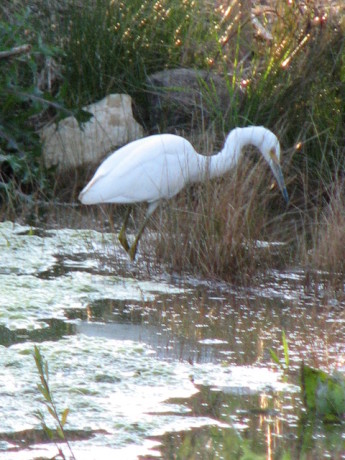
It is estimated that 97% of California’s wetlands are gone. Gone. About two-thirds of that remaining 3% is dysfunctional and polluted. In Los Angeles, only 1% of wetlands remain. We have constructed our properties to drain precious rainwater and even irrigation water into culverts and out to the ocean, rather than collect it in our soil where it belongs. All the riparian animals, from specialized aquatic microbes and fungi up to large mammals, have gradually all but disappeared. What we have instead of wetlands are millions of chlorinated swimming pools, lined ponds and bird baths. Although we may believe that these help animals, the treated water is weakening and killing them with chemicals when they are desperate enough to drink from them, and offer no shelter or food source.
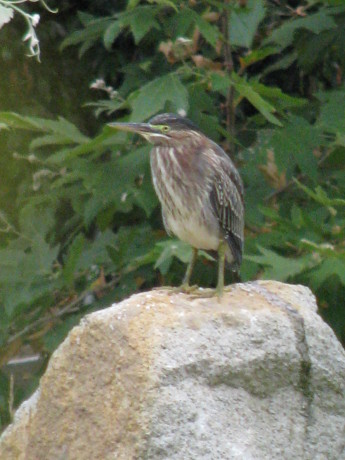
Dr. Bob Lloyd of Pura Vida Aquatics, a Southern California-based business, has spent the last 20 years maintaining ponds chemical-free. “Algicide will kill aquatic microbes, and hurt hummingbirds and all the other creatures that drink it,” he says. To help offset some of the loss of wetlands Dr. Lloyd converts swimming pools into swimming ponds that are cleaned with plants and fish rather than with chemicals.
You may see photos of some methods of pool conversions on the Internet that look fantastic, but really are expensive and drastic, and hard to maintain. They require the draining (and waste) of the 22,000 gallons (more or less) of pool water, the altering of the pool itself by building a cement planting bed along the inside and the filling of that bed with a large amount of gravel. Plants are set in the gravel and after refilling a pump sends water through this system to clean it. The gravel would need to be cleaned over time, which would mean draining water again and hauling out a ton of slimy gravel, and buying new.
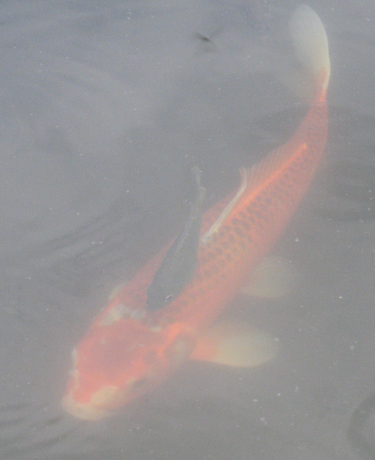
Dr. Lloyd’s system is far less expensive, not invasive to the pool structure at all and is easily removable if years down the road the system is no longer desired. His system is unique and is the product of his PhD in microbiology and his decades of experience working with natural ponds. The plants that are installed are outside of the pool and can have a look that goes with the surrounding vegetation. Even aquatic edibles can be experimented with, such as watercress, water chestnuts and more.
Installing plants inside a pool can be done without changing the pool structure if the pool isn’t going to be used for swimming, or only for gentle laps. The reason is that the splashing water and waves from vigorous swimming is very hard on plants. Many plants die from having too much water on their leaves, and from being battered against the sides of the pool. Using Dr. Lloyd’s method of external decorative plants the pool has the ambiance of a pond and the usability of a regular swimming pool. And you can still swim with koi and other fish! How cool is that?
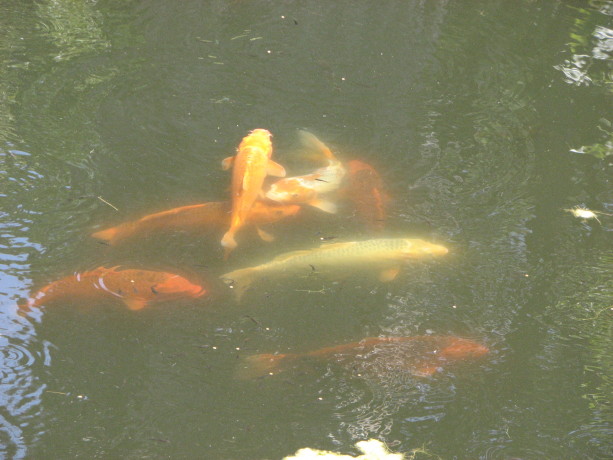 Converting your pool or pond takes a little patience as the biology develops; do you remember the adage that you can’t rush Mother Nature? The evolution of a pool conversion lasts several months. Watching the evolution of a chemical pool to a swimming pond is exciting. With the absence of chlorine, there is a natural algae bloom which turns the inside of the pool a bright, beautiful green. The algae help clear the water of harmful chemicals. As the water is routed through plants, some of the aquatic creatures that balance a pond are added from a local source. As the water clears, fish are added. The fish eat the algae so there are no fuzzy green threads growing up from the bottom or floating on the surface. Fish can be added within weeks of the start of the project. “Its like managing a 20,000 gallon fishtank,” Dr. Lloyd grins.
Converting your pool or pond takes a little patience as the biology develops; do you remember the adage that you can’t rush Mother Nature? The evolution of a pool conversion lasts several months. Watching the evolution of a chemical pool to a swimming pond is exciting. With the absence of chlorine, there is a natural algae bloom which turns the inside of the pool a bright, beautiful green. The algae help clear the water of harmful chemicals. As the water is routed through plants, some of the aquatic creatures that balance a pond are added from a local source. As the water clears, fish are added. The fish eat the algae so there are no fuzzy green threads growing up from the bottom or floating on the surface. Fish can be added within weeks of the start of the project. “Its like managing a 20,000 gallon fishtank,” Dr. Lloyd grins.
Immediately the changes to the environment are apparent. Dragonflies, butterflies, hummingbirds and many more creatures desperate for truly clean (chemical-free) water are attracted to the water and the plants.

“I have clients who tell me how excited they are to see so many birds, insects and lizards in their yards that they’d never seen before,” Dr. Lloyd relates about his converted ponds. “Finding (native) Pacific chorus frogs around the ponds has been very fun.” Some of his clients have become active bird watchers as the wildlife come to ponds that he manages.
Best of all, you can swim with the fish and have no red eyes, green hair or other bad reactions to the harsh chemicals. The plants phytoremediate the water as it is pumped through the planting beds. Children can dangle their feet in the pond without fear of absorbing algicide and other harsh chemicals through their skin.
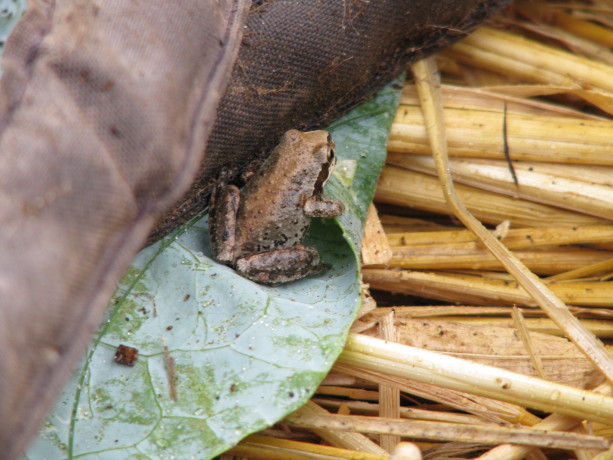
Because we are in a drought, people believe that drying out their pond or pool is necessary. No! Pools evaporate far less water than irrigated lawns and landscapes. What does evaporate helps hold humidity around your plants, something which our drying climate is eliminating. Humidity keeps pollen viable and helps trees and plants survive the lack of rainfall. If you convert your pool and/or pond to a chemical-free one, then it is now supplying habitat to creatures further taxed by dried-up water supplies. What’s more, your pool which isn’t attractive and is rarely used, which must be doctored with chemicals weekly, can be converted into something that benefits wildlife year-round, is interesting to watch all the time, and needs absolutely no chemicals.
Pools are also excellent catchment basins for rain. Instead of buying a large water tank, divert your roof water to your pool and allow the plants to clean it. Then you can use that water at any time during the year for watering plants – with chlorine- and chloramine-free water. In permaculture, everything should have at least three purposes. By converting your pool you can have a free rain-catchment system, a water cleaning system, a safe recreation area, a pleasing view, and some habitat, all while saving money and reducing your carbon footprint and reducing your water bill. How can you not do it?
A converted pool does require weekly maintenance, but not the usual kind with chemicals and cleaners. I remember having to clean the family’s pool when I was growing up and testing the pH, even though we didn’t swim very often. It wasn’t fun. The maintenance on a chemical-free pond consists of checking on the pump, the caring for the plants and fish, and insuring that the clarity of the water and the product is satisfying to the customer. The ecosystem evolves and must be watched. It also costs a fraction of what a pool cleaner charges.
If you have a pond or pool that is on a chemical system, consider a conversion. You’ll spend far less money, have far more entertainment, decorative and educational value, have safe water for your family and wildlife to enjoy, will be helping the environment by not supporting harmful chemicals and by helping off-set the millions of acres of wetlands that are gone.
Dr. Lloyd estimates that he’ll need to convert 1.6 billion swimming pools to offset all the wetlands that have been drained and paved over in California alone. How can it be done?
“One pool at a time,” he smiles.
You can find out about pool and pond conversions by contacting Dr. Bob Lloyd at Pura Vida Aquatics, 310- 429- 8477 http://www.PuraVidaAquatic.com. He has accounts from San Diego through Los Angeles, and can consult elsewhere.

4 Comments
Diane
Hi David! Thank you for reading and commenting. It would be terrific if you had a swimming pond. Without chemicals, there should be a green algal growth around the bottom of the pond, but the water can be made clear through filtration using plants. There is a relatively new book about it, Building Natural Ponds: Create a Clean, Algae-free Pond without Pumps, Filters, or Chemicals by Robert Pavlis which gives a lot of great strategic information. If you can move the water through an area with submerged plants, that’s great. If you cannot, then you can build planter boxes alongside the edge of the pool, fill with potted aquatic plants, and pump the water through these. The strength of your pump and the number of plants are key points. Enduring the possibly several weeks of transition time as you go chemical-free and the pond goes through the algal stage and then into the clarity stage can be trying, but it happens. In your area you don’t appear to have low dips in temperature, so aquatic plants should succeed well. If you have fish in where you swim, you may be able to keep algae eaters and koi, which eat emergent greens and algae, and they will help regulate the growth in the pond. You can also have potted plants in the main area of the pond, but be cautioned. Most plants don’t like their leaves to be repeatedly wettened, which causes leaf spot, so having plants off to the side rather than in a splash zone is best, unless you plan on swimming gently near submerged potted plants in the main area of the pond.
If you want to forego a pump, then you will need to have both plants and fish in the swimming area, and it will be more of a challenge to have absolute clarity. You can achieve clarity several feet down, but perhaps not to the bottom. You will have to stock it heavily with potted plants, and create shelves for the pots as just stairs alone will not offer enough space. Be sure to regulate the number of fish, and use those fish as I just mentioned, also catfish which clean up the bottom, to regulate the pond. You will be able to swim gently without splashing or diving, and you really shouldn’t get any of the water into your eyes or mouth. Growing a good population of daphnea, or other pond creatures native to your area that are part of balancing a pond, would be crucial in a non-filtered pool.
I hope this information helps, and I’d love to see photos of your pool/pond!
Diane
David Zupanc
Hi,
I would like more information on converting my existing swimming pool into a swimming pond.
It currently is functioning as a goldfish habitat with no filtration running. The gold fish are thriving.
But the water isnt clear and it would be great if we can work on this to add some kind of wetland type of area above the pool so have the returning water nice and clear.
I live in the Ipswich area in Queensland, Australia
Diane
Marcyn, if you are in the Southern California area, contact Dr. Bob Lloyd at puravidaaquatic.com, 310 429 8477. If you aren’t you may want to search for a natural pool service in your area, or contact Dr. Bob anyway and see what he has to say!
marcyn del clements
I’m interested! How do I get started?